2014 Peugeot 3008 Hybrid 4 battery
[x] Cancel search: batteryPage 34 of 378

Hybrid system
32
Energy consumption / generation indicator
The indicator dial provides real time information on the total power used, combining electric and Diesel. It comprises three main zones.
POWER zone
Zone which indicates an increased cumulative power demand from your hybrid vehicle, taking account of the combined power available from the Diesel engine and the electric motor.
CHARGE zone
Zone which indicates that the vehicle is in electrical energy recovery phase: on deceleration, braking (partially or particularly with your foot off the accelerator (to use in preference as this gives better energy recovery). This allows the high voltage battery to be recharged using "free" energy which can then be reused for future energy requirements.
ECO zone
Zone which indicates that the vehicle is optimising its energy consumption , electric, Diesel or a combination of both. This zone corresponds to phases of electric running as well as to phases of optimum use of the Diesel engine, which are easily accessible with a suitable driving style (smooth "eco-
citizen" driving).
Page 35 of 378
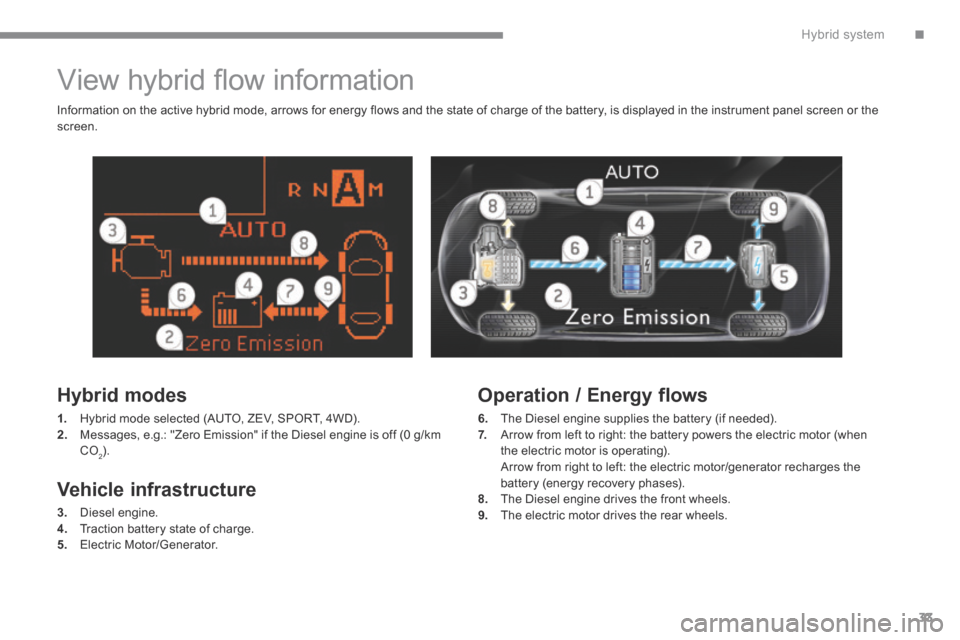
.Hybrid system33
View hybrid fl ow information
Hybrid modes
1. Hybrid mode selected (AUTO, ZEV, SPORT, 4WD). 2. Messages, e.g.: "Zero Emission" if the Diesel engine is off (0 g/km CO2).
Operation / Energy flows
6. The Diesel engine supplies the battery (if needed). 7. Arrow from left to right: the battery powers the electric motor (when the electric motor is operating). Arrow from right to left: the electric motor/generator recharges the battery (energy recovery phases). 8. The Diesel engine drives the front wheels. 9. The electric motor drives the rear wheels.
Vehicle infrastructure
3. Diesel engine. 4. Traction battery state of charge. 5. Electric Motor/Generator.
Information on the active hybrid mode, arrows for energy flows and the state of charge of the battery, is displayed in the instrument panel screen or the screen.
Page 36 of 378
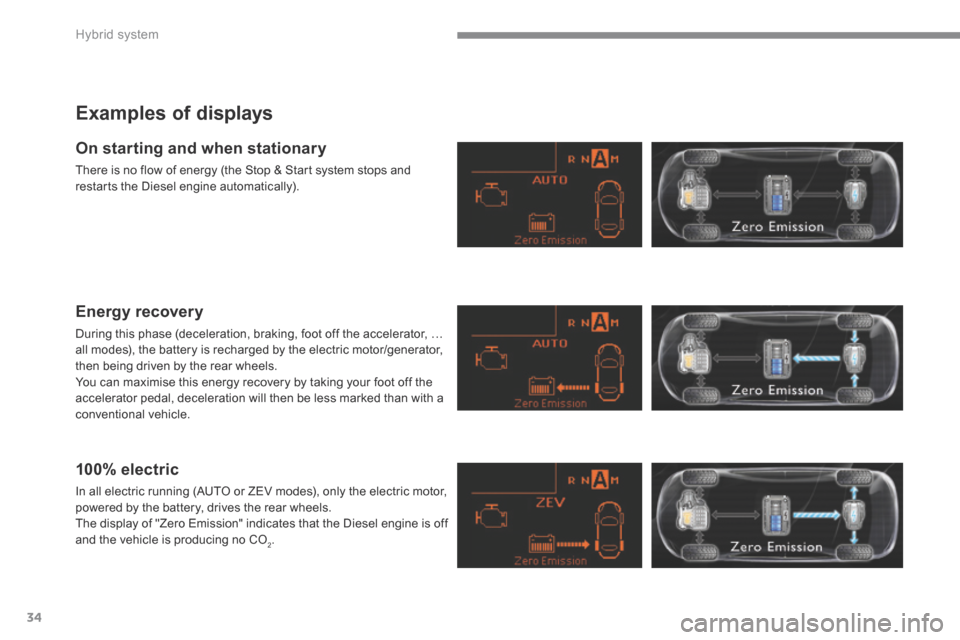
Hybrid system
34
Examples of displays
On starting and when stationary
There is no flow of energy (the Stop & Start system stops and restarts the Diesel engine automatically).
Energy recovery
During this phase (deceleration, braking, foot off the accelerator, … all modes), the battery is recharged by the electric motor/generator, then being driven by the rear wheels. You can maximise this energy recovery by taking your foot off the accelerator pedal, deceleration will then be less marked than with a conventional vehicle.
100% electric
In all electric running (AUTO or ZEV modes), only the electric motor, powered by the battery, drives the rear wheels. The display of "Zero Emission" indicates that the Diesel engine is off
and the vehicle is producing no CO2.
Page 37 of 378

.Hybrid system35
The internal combustion engine may restart or ZEV mode may not be available in the various conditions presented below. The internal combustion engine can be switched off automatically as soon as these conditions are lifted. When the conditions described below cause the vehicle to come out of ZEV mode and the Diesel engine to restart, the vehicle automatically changes to AUTO mode.
Action by the driver
- Moving the gear selector to position M . - Action on steering mounted control paddles to change gear. - Sustained and sharp acceleration. - Use of demisting. - Use of air conditioning.
- If the high voltage battery is not sufficiently charged. A minimum of 4 bars in ZEV mode so as to ensure operation over a certain distance (in AUTO, electric operation is accessible for a shorter period with a lower level of charge). - When the fuel level enters the reserve zone (where rate of consumption of this reserve is high, ZEV inhibition may continue for some time after refuelling). - During regeneration of the particle emissions filter, which occurs automatically for 5 to 10 minutes, approximately every 300 miles (500 kms) (or less in extended urban running).
Diffi cult weather conditions and circumstances
- If certain conditions or engine temperature requirements make it necessary (such as an engine temperature that is too low for the ambient conditions). - When the battery is close to maximum charge (for example: when going down a long hill), because engine recovery being no longer possible, the internal combustion engine restarts automatically just to provide engine braking. - If the vehicle encounters a steep slope (car park ramp, ...). - If the vehicle has been parked in the sun for a prolonged period. - When driving in mountainous conditions (altitude).
Automatic restarting of the Diesel engine or ZEV mode NOT available
Your vehicle is fitted with the most effective emissions control systems, in particular the Particle Emissions Filter (PEF). At regular intervals your Diesel engine will produce energy for the self-cleaning of this f i l t e r. During this PEF regeneration phase, electric running is purposely made
unavailable and is accompanied by a message " Electric mode not available: PEF regeneration in progress ".
Maintaining the performance of the system
- When the vehicle exceeds 18 mph (30 km/h) after moving off (if the internal combustion engine has not already started since the vehicle was last started).
Page 39 of 378
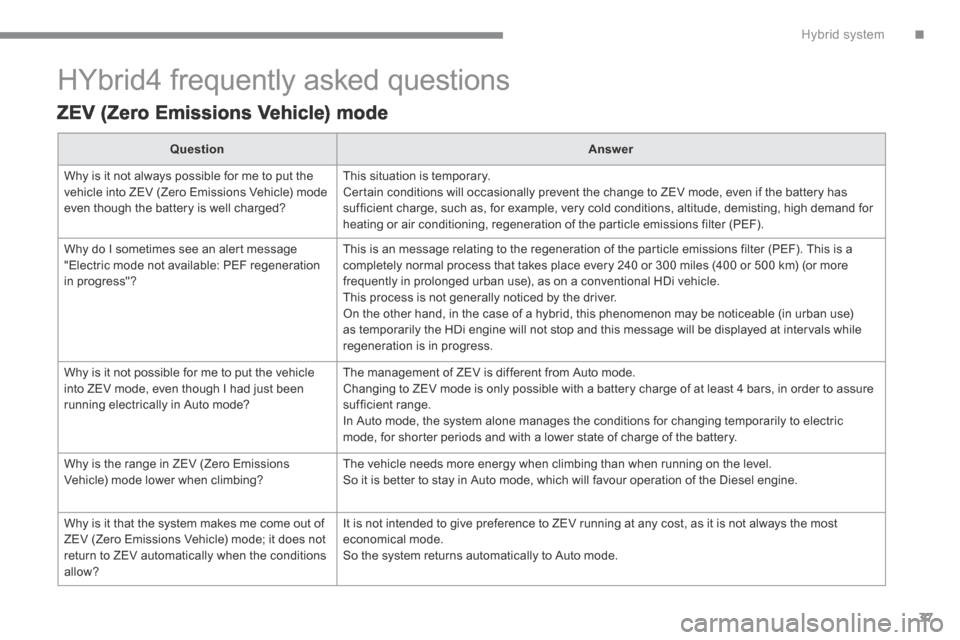
.Hybrid system37
HYbrid4 frequently asked questions
ZEV (Zero Emissions Vehicle) mode
QuestionAnswer
Why is it not always possible for me to put the vehicle into ZEV (Zero Emissions Vehicle) mode even though the battery is well charged?
This situation is temporary. Certain conditions will occasionally prevent the change to ZEV mode, even if the battery has sufficient charge, such as, for example, very cold conditions, altitude, demisting, high demand for
heating or air conditioning, regeneration of the particle emissions filter (PEF).
Why do I sometimes see an alert message "Electric mode not available: PEF regeneration in progress"?
This is an message relating to the regeneration of the particle emissions filter (PEF). This is a completely normal process that takes place every 240 or 300 miles (400 or 500 km) (or more frequently in prolonged urban use), as on a conventional HDi vehicle. This process is not generally noticed by the driver. On the other hand, in the case of a hybrid, this phenomenon may be noticeable (in urban use) as temporarily the HDi engine will not stop and this message will be displayed at intervals while regeneration is in progress.
Why is it not possible for me to put the vehicle into ZEV mode, even though I had just been running electrically in Auto mode?
The management of ZEV is different from Auto mode. Changing to ZEV mode is only possible with a battery charge of at least 4 bars, in order to assure sufficient range. In Auto mode, the system alone manages the conditions for changing temporarily to electric
mode, for shorter periods and with a lower state of charge of the battery.
Why is the range in ZEV (Zero Emissions Vehicle) mode lower when climbing? The vehicle needs more energy when climbing than when running on the level. So it is better to stay in Auto mode, which will favour operation of the Diesel engine.
Why is it that the system makes me come out of ZEV (Zero Emissions Vehicle) mode; it does not return to ZEV automatically when the conditions allow?
It is not intended to give preference to ZEV running at any cost, as it is not always the most economical mode. So the system returns automatically to Auto mode.
Page 40 of 378
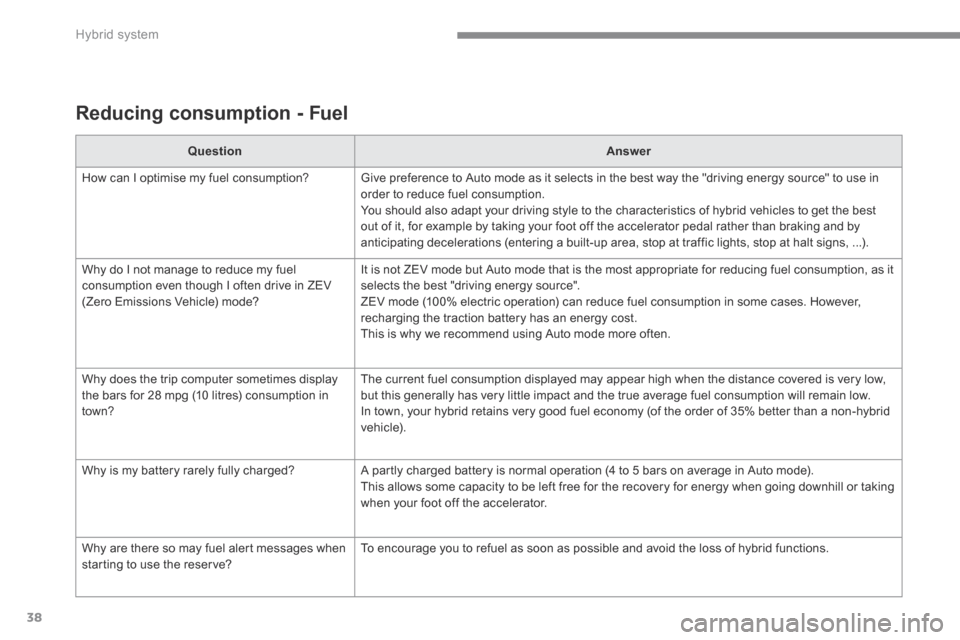
Hybrid system
38
Reducing consumption - Fuel
QuestionAnswer
How can I optimise my fuel consumption? Give preference to Auto mode as it selects in the best way the "driving energy source" to use in order to reduce fuel consumption. You should also adapt your driving style to the characteristics of hybrid vehicles to get the best out of it, for example by taking your foot off the accelerator pedal rather than braking and by anticipating decelerations (entering a built-up area, stop at traffic lights, stop at halt signs, ...).
Why do I not manage to reduce my fuel consumption even though I often drive in ZEV (Zero Emissions Vehicle) mode?
It is not ZEV mode but Auto mode that is the most appropriate for reducing fuel consumption, as it selects the best "driving energy source". ZEV mode (100% electric operation) can reduce fuel consumption in some cases. However, recharging the traction battery has an energy cost. This is why we recommend using Auto mode more often.
Why does the trip computer sometimes display the bars for 28 mpg (10 litres) consumption in town?
The current fuel consumption displayed may appear high when the distance covered is very low, but this generally has very little impact and the true average fuel consumption will remain low. In town, your hybrid retains very good fuel economy (of the order of 35% better than a non-hybrid vehicle).
Why is my battery rarely fully charged? A partly charged battery is normal operation (4 to 5 bars on average in Auto mode). This allows some capacity to be left free for the recovery for energy when going downhill or taking when your foot off the accelerator.
Why are there so may fuel alert messages when starting to use the reserve? To encourage you to refuel as soon as possible and avoid the loss of hybrid functions.
Page 45 of 378
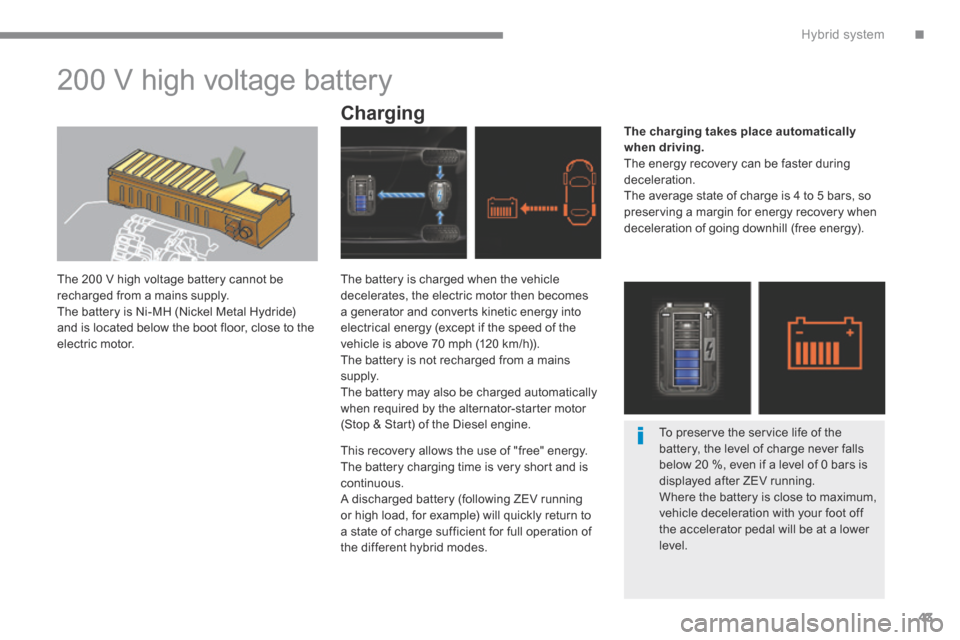
.Hybrid system43
200 V high voltage battery
The 200 V high voltage battery cannot be recharged from a mains supply. The battery is Ni-MH (Nickel Metal Hydride) and is located below the boot floor, close to the electric motor.
Charging The charging takes place automatically when driving . The energy recovery can be faster during deceleration. The average state of charge is 4 to 5 bars, so preserving a margin for energy recovery when deceleration of going downhill (free energy).
The battery is charged when the vehicle decelerates, the electric motor then becomes a generator and converts kinetic energy into electrical energy (except if the speed of the vehicle is above 70 mph (120 km/h)). The battery is not recharged from a mains supply. The battery may also be charged automatically when required by the alternator-starter motor (Stop & Start) of the Diesel engine.
This recovery allows the use of "free" energy. The battery charging time is very short and is continuous. A discharged battery (following ZEV running or high load, for example) will quickly return to a state of charge sufficient for full operation of the different hybrid modes.
To preserve the service life of the battery, the level of charge never falls below 20 %, even if a level of 0 bars is displayed after ZEV running. Where the battery is close to maximum, vehicle deceleration with your foot off the accelerator pedal will be at a lower
level.
Page 46 of 378
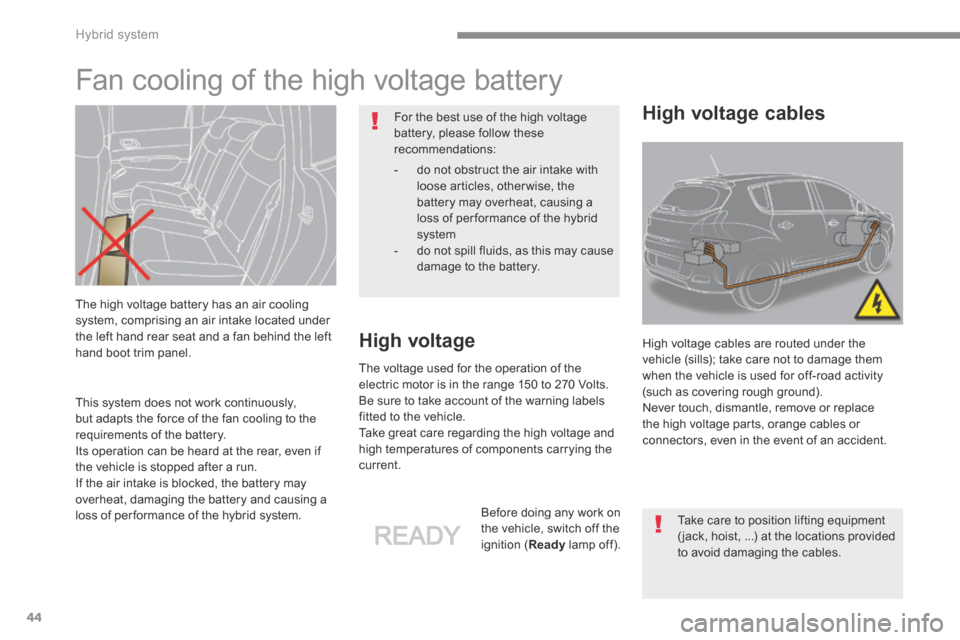
Hybrid system
44
This system does not work continuously, but adapts the force of the fan cooling to the
requirements of the battery. Its operation can be heard at the rear, even if the vehicle is stopped after a run. If the air intake is blocked, the battery may overheat, damaging the battery and causing a loss of per formance of the hybrid system.
Fan cooling of the high voltage battery
The high voltage battery has an air cooling system, comprising an air intake located under the left hand rear seat and a fan behind the left hand boot trim panel. High voltage
The voltage used for the operation of the electric motor is in the range 150 to 270 Volts. Be sure to take account of the warning labels fitted to the vehicle. Take great care regarding the high voltage and high temperatures of components carrying the current.
Before doing any work on the vehicle, switch off the ignition ( Ready lamp off).
High voltage cables are routed under the vehicle (sills); take care not to damage them when the vehicle is used for off-road activity (such as covering rough ground). Never touch, dismantle, remove or replace the high voltage parts, orange cables or
connectors, even in the event of an accident.
High voltage cables For the best use of the high voltage battery, please follow these recommendations:
- do not obstruct the air intake with loose articles, otherwise, the battery may overheat, causing a loss of per formance of the hybrid system - do not spill fluids, as this may cause damage to the battery.
Take care to position lifting equipment ( jack, hoist, ...) at the locations provided to avoid damaging the cables.